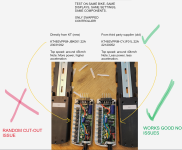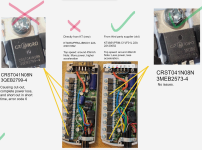Hi!
I have the following issue:
Sometimes the motor assistance completely cuts-out and does only reingage when I stop pedalling for a second or two and/or release the throttle and then start again. The display stays on, it's only the motor that cuts out. It seems to can happen in any assist level, and only occurs within the 1-2 seconds after you start pedalling or engage the throttle. The strange thing is that it only does this like 1 out of 100 times. 99% of the time it works perfect, and then sometimes randomly it doesn't. When it happens and I just continue pedalling or use the throttle it won't ever work. You really have to stop pedalling to break the cycle or something. So it is also not the same a the brake cut-off for example.
My set-up:
Controller: KT48SVPRM-JBK001 22A (built-into Hailong battery deck)
Display: KT LCD3 V3.0 3CM
Motor: Bafang 500W geared hub motor
Display settings:
P1 100
P2 6
P3 1
P4 0
P5 15
C1 7
C2 0
C3 0
C4 0
C5 10
C6 5
C7 1
C8 0
C9 0
C10
C11 0
C12 2
C13 0
C14 3
C15 6
What I have tested:
- Changed the PAS sensor to one of KT (KT-V12L), did not make a difference, same issue.
- I had the feeling it might be a BMS cut-out, therefore I tested with a battery that doesn't have a BMS, although same issue, so also not BMS/battery related.
I am completely clueless, since it is so random. I have a lot of experience with KT controllers, but have never had these issue before.
These controllers and displays are ordered directly from the KT factory, I ordered 10 sets, all have these problem. I suspect some sort of weird firmware issue, someone has any thoughts?
I have the following issue:
Sometimes the motor assistance completely cuts-out and does only reingage when I stop pedalling for a second or two and/or release the throttle and then start again. The display stays on, it's only the motor that cuts out. It seems to can happen in any assist level, and only occurs within the 1-2 seconds after you start pedalling or engage the throttle. The strange thing is that it only does this like 1 out of 100 times. 99% of the time it works perfect, and then sometimes randomly it doesn't. When it happens and I just continue pedalling or use the throttle it won't ever work. You really have to stop pedalling to break the cycle or something. So it is also not the same a the brake cut-off for example.
My set-up:
Controller: KT48SVPRM-JBK001 22A (built-into Hailong battery deck)
Display: KT LCD3 V3.0 3CM
Motor: Bafang 500W geared hub motor
Display settings:
P1 100
P2 6
P3 1
P4 0
P5 15
C1 7
C2 0
C3 0
C4 0
C5 10
C6 5
C7 1
C8 0
C9 0
C10
C11 0
C12 2
C13 0
C14 3
C15 6
What I have tested:
- Changed the PAS sensor to one of KT (KT-V12L), did not make a difference, same issue.
- I had the feeling it might be a BMS cut-out, therefore I tested with a battery that doesn't have a BMS, although same issue, so also not BMS/battery related.
I am completely clueless, since it is so random. I have a lot of experience with KT controllers, but have never had these issue before.
These controllers and displays are ordered directly from the KT factory, I ordered 10 sets, all have these problem. I suspect some sort of weird firmware issue, someone has any thoughts?






